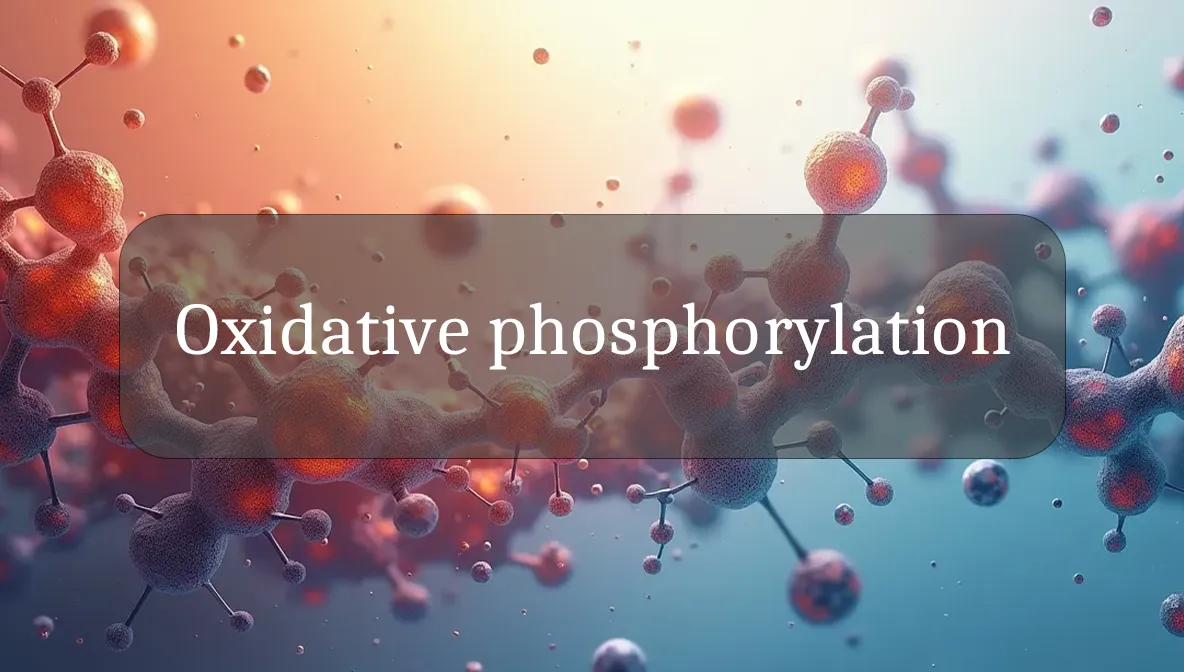Your Cells’ Power Plant
Oxidative phosphorylation is the process your cells use to generate energy, producing ATP (adenosine triphosphate), the body’s main energy currency. It’s like a cellular power plant, fueling everything from muscle movement to brain activity. Let’s explore what oxidative phosphorylation is, its role in your wellness, and how to support it for daily vitality.
Identity and Function
Oxidative phosphorylation is a metabolic process that occurs in the mitochondria, specifically in the inner mitochondrial membrane. It uses energy from the electron transport chain (ETC) to drive ATP synthesis via the enzyme ATP synthase. Electrons from nutrients (like glucose or fats) are passed through the ETC, creating a proton gradient that powers ATP production. Oxygen acts as the final electron acceptor, forming water. This process generates about 90% of your body’s ATP, making it essential for energy-intensive activities.
Biological Role and Health Impact
Oxidative phosphorylation is critical for keeping your body energized and functional:
- Energy Production: It produces ATP to power muscle contractions, nerve signaling, and organ function, keeping you active and alert.
- Metabolic Efficiency: It maximizes energy yield from food (up to 30–36 ATP per glucose molecule), supporting endurance and daily tasks.
- Brain Function: ATP fuels neurons, supporting memory, focus, and decision-making.
- Heart and Muscle Health: It provides energy for constant heartbeats and muscle movements, enhancing physical performance.
- Cellular Repair: ATP supports cell maintenance and repair, aiding recovery from exercise or injury.
By generating energy efficiently, oxidative phosphorylation keeps you strong, focused, and resilient.
Production and Sources
Oxidative phosphorylation is a natural process, driven by nutrients and oxygen:
- How It Works: Mitochondria in cells (especially in muscles, liver, and brain) use nutrients from carbs (e.g., glucose), fats, or proteins to feed the ETC. Oxygen from breathing enables the process, producing ATP, water, and heat.
- Dietary Influence: Carbs (rice, fruits), fats (nuts, oils), and proteins (eggs, fish) provide fuel for the ETC. Coenzyme Q10 (found in meat, fish) and B vitamins (whole grains, eggs) support mitochondrial enzymes.
- Key Nutrients: Iron (spinach, red meat), magnesium (nuts, seeds), and vitamin C (berries, peppers) aid ETC function and oxygen use.
- No External Sources: ATP is produced internally; you don’t consume it directly.
A nutrient-rich diet and good oxygen supply support efficient oxidative phosphorylation.
Signs of Imbalance
Impaired oxidative phosphorylation can lead to energy deficits or health issues:
- Mitochondrial Dysfunction:
- Fatigue, muscle weakness, or exercise intolerance, as cells struggle to produce ATP.
- Brain fog, memory issues, or mood changes due to low energy in neurons.
- Metabolic Issues:
- Unexplained weight gain or difficulty maintaining energy, linked to inefficient fuel use.
- Lactic acid buildup (muscle soreness, nausea) if cells rely on less efficient pathways (e.g., glycolysis).
- Genetic Disorders:
- Symptoms like seizures, muscle wasting, or developmental delays in rare mitochondrial diseases (e.g., Leigh syndrome). If you notice persistent fatigue, muscle issues, or neurological symptoms, see a doctor for tests like mitochondrial DNA analysis or blood lactate levels.
Supporting Healthy Function
To keep oxidative phosphorylation efficient and energy-high:
- Eat a Balanced Diet: Include complex carbs (oats, quinoa), healthy fats (avocado, salmon), and proteins (chicken, beans) to provide steady fuel for ATP production.
- Support Mitochondrial Health: Eat foods rich in CoQ10 (sardines, beef), B vitamins (eggs, whole grains), and antioxidants (berries, spinach) to protect mitochondria from oxidative stress.
- Exercise Regularly: Aim for 30 minutes most days (e.g., jogging, swimming) to boost mitochondrial number and efficiency, enhancing ATP production.
- Stay Hydrated: Drink 8–10 cups of water daily to support cellular processes and oxygen delivery.
- Get Enough Oxygen: Practice deep breathing or spend time in fresh air to ensure adequate oxygen for the ETC.
Safety and Precautions
Oxidative phosphorylation is a natural process, but health conditions or factors require care:
- Medical Conditions: Mitochondrial disorders, diabetes, or heart disease can impair ATP production, needing medical management.
- Medications: Some drugs (e.g., certain antibiotics or statins) may affect mitochondria. Use as prescribed and discuss side effects with your doctor.
- Environmental Toxins: Exposure to pollutants, heavy metals, or excessive alcohol can damage mitochondria, reducing ATP output. Minimize exposure where possible.
- Oxidative Stress: Free radicals from poor diet or smoking can harm mitochondria. Eat antioxidant-rich foods (fruits, veggies) to counteract this.
- Aging: Mitochondrial function declines with age, affecting energy. A healthy lifestyle can slow this process.
If you have chronic fatigue, muscle issues, or metabolic concerns, consult a healthcare provider for tests like mitochondrial function assays or bloodwork.
Fun Fact
Did you know oxidative phosphorylation is so efficient it can produce enough ATP to power your body for a whole day from just one slice of bread? It’s like squeezing a tank of gas out of a single snack!
Citations
- National Institutes of Health (NIH): Mitochondrial Function and Oxidative Phosphorylation.
- Mayo Clinic: Energy Metabolism and Fatigue.
- Cleveland Clinic: Understanding Mitochondrial Health.
- American Society for Biochemistry: ATP Production Pathways.
- Journal of Bioenergetics: Oxidative Phosphorylation and Health (2020).

